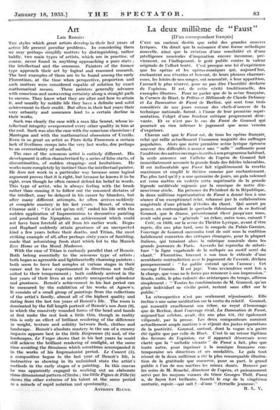Art
Late Renoirs Tim styles which great artists develop in their last years of active life present peculiar problems. In considering them we may perhaps simplify matters by distinguishing, rather baldly, two main types of artists, which are in practice, of course, never found in anything approaching a pure state : the intellectual and the sensuous. Painters of the former type approach their art by logical and reasoned research. The best examples of them are to be found among the early Florentines, at the time when perspective, proportion and such matters were considered capable of solution by exact mathematical means. These painters generally advance with conscious and unwavering certainty along a straight path to success. They know what they are after and how to attain it, and usually by middle- life they have a definite- and solid achievement to their credit. But often in their last years their very urbanity and assurance lead to a certain decline in their works.
Such was clearly the case with a man like Seurat, whose in- tellectual integrity overpowered every other quality in him at the end. Such was also the case with the conscious classicism c f Mantegna and with the mathematical obsessions of Uccello. Even in so great an artist as Piero della" Francesca a certain lack of liveliness creeps into the very last works, due perhaps to an overcertainty of method.
The case of the sensuous artist is entirely different. His development is often characterized by a series of false starts, of discontinuities, of sudden stoppings and hesitations. He works more completely by instinct than the intellectual painter. He does not work in a particular way because some logical argument proves that it is right, but because he knows it to be right, even though he often cannot defend his belief in words. This type of artist, who is always feeling with the brush rather than causing it to follow out the reasoned dictates of the intellect, may be delayed in his career by blunders, but after many different attempts, he often arrives suddenly at complete mastery in his last years. Monet, of whom Cezanne said : " Ce n'est qu'un coil," ended his life with the sudden application of Impressionism to decorative painting and produced the Nympheas, an achievement which could not have been foretold at all from his earlier work. Degas and Raphael suddenly attain greatness of an unexpected kind a few years before their deaths, and Titian, the most striking example of all, after perhaps sixty years of fumbling, made that astonishing fresh start which led to the Munich Ecce Homo or the Mond Madonna.
With the case of Titian is curiously parallel that of Renoir. Both belong essentially to the sensuous type of artists ; both began as agreeable and lightheartedly charming painters ; both seem to have had scruples at various stages in their career and to have experimented in directions not really suited to their temperament ; both suddenly arrived in the last years of their lives at an utterly unexpected splendour and greatness. Renoir's achievement in his last period can be measured by the exhibition of his works at Agnew's. It consists of a small group of paintings from the collections of the artist's family, almost all of the highest quality and dating from the last ten years of Renoir's life. The room is dominated by the full length portrait of Renoir's son Jean (9), in which the massively rounded forms of the head and hands at first make the rest look a little thin, though in reality this is only an effect of brilliant rendering of the difference in weight, texture and solidity between flesh, clothes and landscape. Renoir's absolute mastery in the use of a creamy impasto appears best in the little Baigneuses (8) and, of the landscapes, Le Verger shows that in his last years he could still achieve the brilliant rendering of sunlight, at the same time avoiding the flimsiness which sometimes accompanied it in the works of his Impressionist period. Le Concert (5), a composition begun in the last year of Renoir's life, is instructive as showing in its unfinished state the artist's methods in the early stages of a painting. In this canvas he was apparently engaged in working out an elaborate three dimensional pattern of limbs ; the little Figure de Fille (3) shows the other extreme of his talent at the same period in a miracle of rapid notation and spontaneity..
ANTHONY BLUNT.






































 Previous page
Previous page